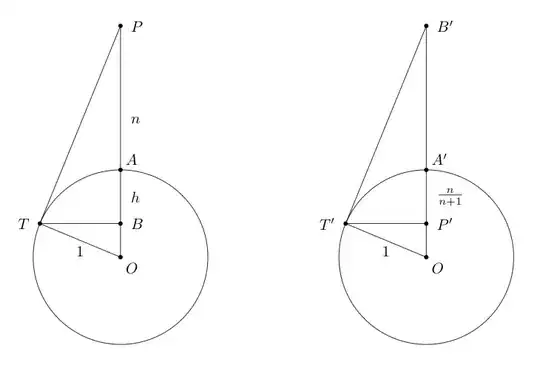@André, @Rahul Thanks for the responses. I don't really have any problem with the fact that the area of a spherical cap is proportional to its height; I was wondering if there was an insight that would prompt me to say ``Oh, it's obvious that the rate of change of the height of the cap is proportional to the square of the rate of change of the distance of the observing point to the center of the sphere, since [brilliant insight here].''
While mulling it over for more time than the problem's worth to get a ``no'' answer, I did recall a useful technique that I all too frequently neglect to consider: using circle inversion
Starting with a slice through the observing point, $P$, and the center, $O$, of the sphere we have the left picture below, where the length of the segment $AB$ is the height we want.
 Now transform this picture with respect to the reference circle (assumed to be a unit circle) so that a point $X$ of distance $R$ on the ray through the center of the circle is transformed to a point $X'$ on the same ray but with distance $1/R$ from the center. Doing this, we wind up with the picture on the right. While inversion has a lot of interesting properties (not the least of which is the fact that inversion fixes points on the reference circle), the useful property in this situation is that any two points and the origin will form a triangle that is similar to the triangle formed by inverting the two points ($\angle OBT = \angle OT'B'$, for example). This means that the left and right pictures are exactly the same, so a bit of adding and subtracting 1 from various quantities gives us the result that $h=n/(n+1)$, which is exactly the answer we needed.
Now transform this picture with respect to the reference circle (assumed to be a unit circle) so that a point $X$ of distance $R$ on the ray through the center of the circle is transformed to a point $X'$ on the same ray but with distance $1/R$ from the center. Doing this, we wind up with the picture on the right. While inversion has a lot of interesting properties (not the least of which is the fact that inversion fixes points on the reference circle), the useful property in this situation is that any two points and the origin will form a triangle that is similar to the triangle formed by inverting the two points ($\angle OBT = \angle OT'B'$, for example). This means that the left and right pictures are exactly the same, so a bit of adding and subtracting 1 from various quantities gives us the result that $h=n/(n+1)$, which is exactly the answer we needed.
Whether you find this more or less transparent than other techniques is, of course, up to you, but I thought it was interesting enough to serve as an answer to my own question.
 Now transform this picture with respect to the reference circle (assumed to be a unit circle) so that a point $X$ of distance $R$ on the ray through the center of the circle is transformed to a point $X'$ on the same ray but with distance $1/R$ from the center. Doing this, we wind up with the picture on the right. While inversion has a lot of interesting properties (not the least of which is the fact that inversion fixes points on the reference circle), the useful property in this situation is that any two points and the origin will form a triangle that is similar to the triangle formed by inverting the two points ($\angle OBT = \angle OT'B'$, for example). This means that the left and right pictures are exactly the same, so a bit of adding and subtracting 1 from various quantities gives us the result that $h=n/(n+1)$, which is exactly the answer we needed.
Now transform this picture with respect to the reference circle (assumed to be a unit circle) so that a point $X$ of distance $R$ on the ray through the center of the circle is transformed to a point $X'$ on the same ray but with distance $1/R$ from the center. Doing this, we wind up with the picture on the right. While inversion has a lot of interesting properties (not the least of which is the fact that inversion fixes points on the reference circle), the useful property in this situation is that any two points and the origin will form a triangle that is similar to the triangle formed by inverting the two points ($\angle OBT = \angle OT'B'$, for example). This means that the left and right pictures are exactly the same, so a bit of adding and subtracting 1 from various quantities gives us the result that $h=n/(n+1)$, which is exactly the answer we needed.